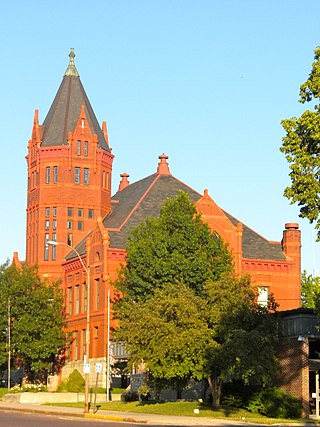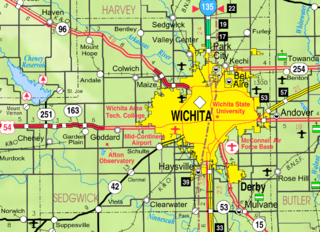
Nemaha County is a county located in the northeastern part of the U.S. state of Kansas. Its county seat is Seneca. As of the 2020 census, the county population was 10,273. The county was named for the Nemaha River.

Marshall County is a county located in the U.S. state of Kansas. Its county seat and largest city is Marysville. As of the 2020 census, the county population was 10,038. The county was named after Frank J. Marshall, a state representative who operated the first ferry over the Big Blue River.

Hardtner is a city in Barber County, Kansas, United States. As of the 2020 census, the population of the city was 167. It is located 1 mile north of the Kansas / Oklahoma state border.

Morrill is a city in Brown County, Kansas, United States. As of the 2020 census, the population of the city was 218.

Udall is a city in Cowley County, Kansas, United States. As of the 2020 census, the population of the city was 661.

Chapman is a city in Dickinson County, Kansas, United States. As of the 2020 census, the population of the city was 1,377.

Hill City is a city in and the county seat of Graham County, Kansas, United States. As of the 2020 census, the population of the city was 1,403.

Pleasanton is a city in Linn County, Kansas, United States. As of the 2020 census, the population of the city was 1,208.

Reading is a city in Lyon County, Kansas, United States. As of the 2020 census, the population of the city was 181.

Axtell is a city in Marshall County, Kansas, United States. As of the 2020 census, the population of the city was 399.

Marquette is a city in McPherson County, Kansas, United States. As of the 2020 census, the population of the city was 599. It is located between K-4 and the Smoky Hill River.

Bern is a city in Nemaha County, Kansas, United States. As of the 2020 census, the population of the city was 161.

Wetmore is a city in Nemaha County, Kansas, United States. As of the 2020 census, the population of the city was 348.

Tescott is a city in Ottawa County, Kansas, United States. As of the 2020 census, the population of the city was 265. It is located northwest of Salina at the intersection of 30th Road and K-18 highway, next to an abandoned railroad.

Rozel is a city in Pawnee County, Kansas, United States. As of the 2020 census, the population of the city was 102.

Westmoreland is a city in and the county seat of Pottawatomie County, Kansas, United States. As of the 2020 census, the population of the city was 740.

Haysville is a city in Sedgwick County, Kansas, United States, and a suburb of Wichita. As of the 2020 census, the population of the city was 11,262. Haysville is known as the "Peach Capital of Kansas".

Selden is a city in Sheridan County, Kansas, United States. As of the 2020 census, the population of the city was 184.

Harveyville is a city in Wabaunsee County, Kansas, United States. As of the 2020 census, the population of the city was 178. It is located 8.5 miles (13.7 km) northwest of the city of Burlingame.

Greenleaf is a city in Washington County, Kansas, United States. As of the 2020 census, the population of the city was 350.


























